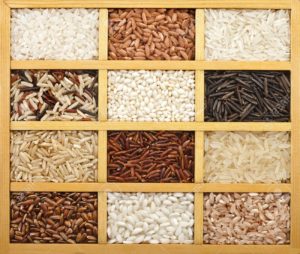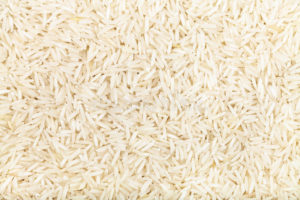
Basmati rice has a particularly long grain which elongates further during cooking. Short-grained rices tend to be sticky when cooked. Use them in rice pudding or for sushi. Longer grained varieties remain fluffy when cooked and are commonly used in Indian and various Asian cuisines.
Rice growing in fields and paddies has three edible parts – the bran, the germ, and the endosperm – just like all other whole grains. Most of us think of “brown rice” as being synonymous with whole grain rice, but in fact whole grain rice can be many different colors, depending on the variety of rice.
Bad rice happens to every cook—it’s wet when you want it dry, it’s clumpy when you want it fluffy. The only way to perfect it is with practice (or, you know, a rice cooker). But one thing you can do to get your rice started on the right foot right away: pick the right kind of rice.

There are hundreds of rice varieties, but they generally fall into three categories: Long-grain, medium-grain, and short-grain, each of which has its own properties. Here, a quick primer.
LONG-GRAIN
A slim type of rice that cooks up fluffy and doesn’t clump the way, say, short-grain rice does. This is the most forgiving rice, the variety that will most often turn out the way you want it. So use it when you’re making a simple pilaf, or a pot of rice to go alongside a piece of fish. Two specific varieties to have on hand: Basmati and Jasmine.
MEDIUM-GRAIN
A little squatter than long-grain, medium-grain rice is thought by some to be essentially the same as short-grain rice. It’s true that it cooks up sticky, like short-grain, and you can usually substitute one for the other without much consequence. But when you really want true risotto or paella, you need medium-grain rices such as Arborio, Valencia, and Bomba.
SHORT-GRAIN
The fattest, roundest breed of rice. It cooks up sticky and clumpy—think sushi rice, which is always short-grain. Making sticky rice? Don’t reach for anything else.
Improved Varieties :
Punjab Basmati 2 (2008) – This variety is about 125 cm tall and is weakly photo period sensitive. It possesses extra long slender grains with excellent cooking and eating qualities.Grains of this variety are strongly scented. Grains almost double upon cooking, are non sticky and soft to eat. It matures in about 140 days after seeding. Its average yield is 12.6 quintals of paddy per acre.
Super Basmati (2003) – This variety is about 113 cm tall and is weakly photo period sensitive. It performs best under medium fertility conditions. It possesses extra long, super fine grains with excellent cooking quality and strong aroma. The cooked rice is non-sticky and soft to eat. It matures in about 145 days after seeding. Its average yield is 14 quintal of paddy per acre.
Basmati 386 (1995) – This variety is about 180 cm tall and is photo period sensitive. It performs best under medium fertility conditions. Its grains are extra-long, superfine and aromatic. Grains elongate almost double on cooking. The cooked rice is non-sticky and soft to eat. It matures in about 155 days from seeding. Its average yield is 9 quintal paddy per acre.
Pusa Basmati No. 1 (1990) – This variety is about 100 cm tall and is photo period insensitive. It performs best under high fertility soils. Its grains are superfine and elongate well upon cooking. Its rice has mild aroma. The cooked rice is non-sticky and soft to eat. It matures in
about 140 days.
 Its average yield is about 16 quintal of paddy per acre.
Its average yield is about 16 quintal of paddy per acre.
Basmati 370 – This variety is about 165 cm tall, photo period sensitive and lodge under high fertility conditions. It does best on average fertility soils. Its grains are superfine, highly aromatic and elongate almost double upon cooking. The cooked rice is non sticky and soft to eat. It matures in about 150 days. Its average yield is 12 quintal paddy per acre.
Pusa Basmati 1121 (2008) : It is about 120 cm tall. It possesses extra long slender grains with good cooking quality. It has longest cooked rice length among all the aromatic rice varieties recommended for Punjab. It is photo period insensitive and matures in about 137 days after seeding. It yields on an average 13.7 quintals of paddy per acre.
Aromatic Rice
It includes both basmati and non basmati rice varieties. They have one or more of other attributes of the basmati rice but not all of them.
Punjab Mehak 1 (2009) : It is an aromatic rice variety. It is photo period in sensitive and is about 100 cm tall. It possesses extra long slender, clear translucent grains with strong aroma. It has excellent cooking and eating qualities. The cooked rice is non-sticky and soft to eat. It matures in about 125 days after seeding. It is resistant to most of the patho types of bacterial blight prevalent in Punjab. Its average paddy yield is about 17 quintal per acre.
